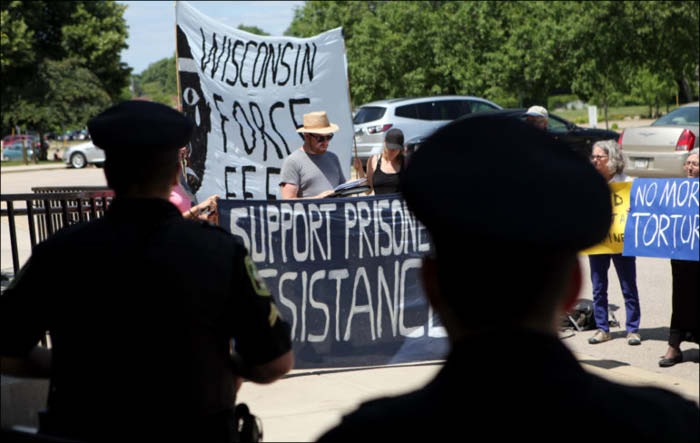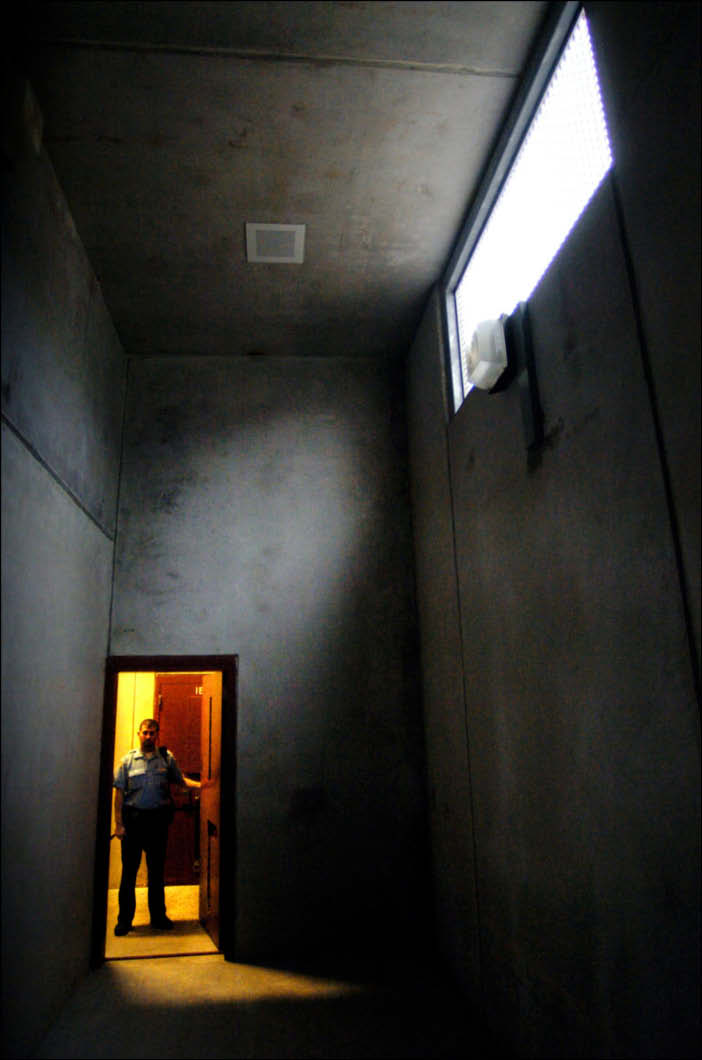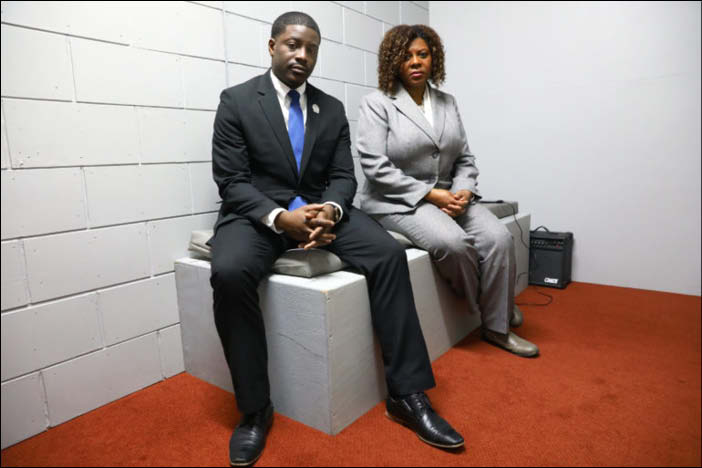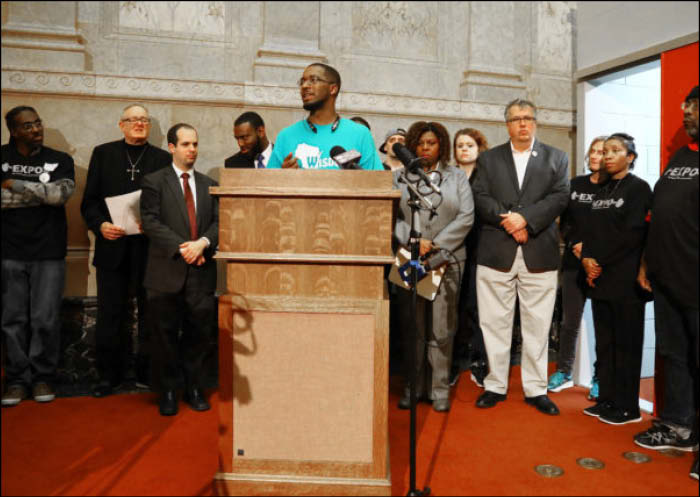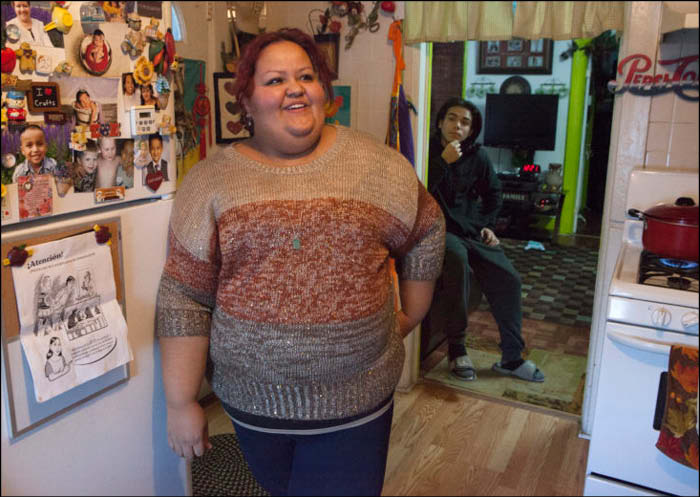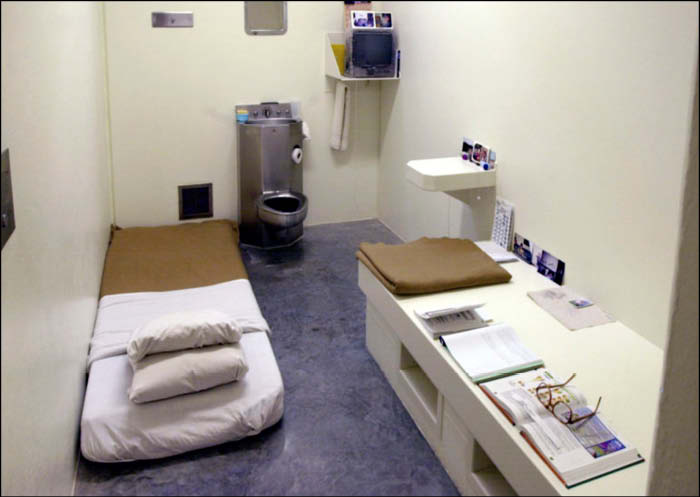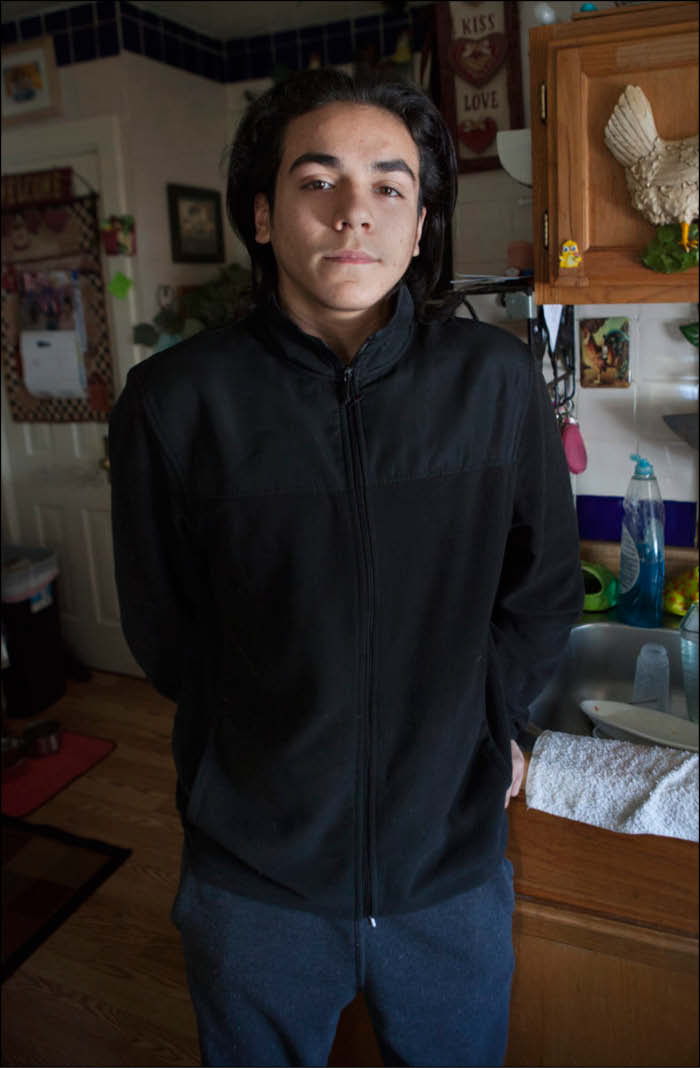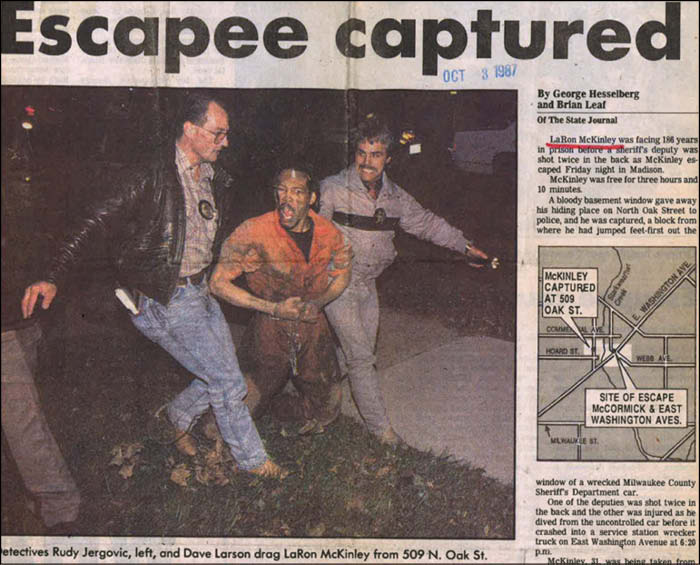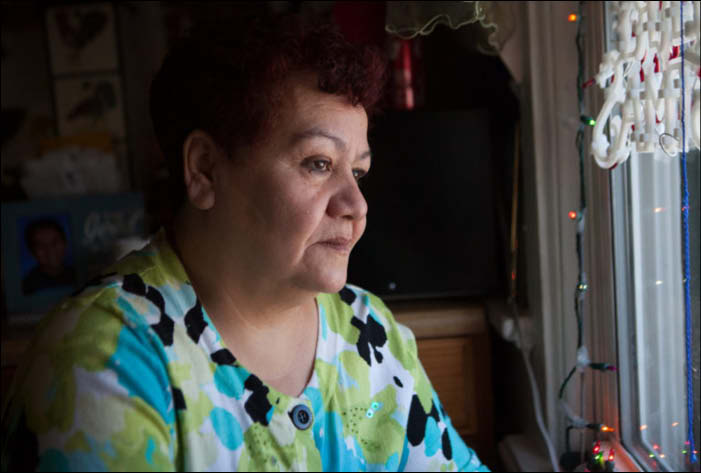Ben Turk reads a list of demands and rule and policy changes that hunger strikers were seeking outside the state Department of Corrections headquarters in Madison, Wis. on July 5, 2016. Protesters were trying to pressure the Wisconsin Department of Corrections to reduce use of solitary confinement including ending a form of isolation known as administrative confinement that has no set end date. (Coburn Dukehart | Wisconsin Center for Investigative Journalism)
Roughly 900 inmates are in solitary confinement at any one time in Wisconsin prisons, including at the Wisconsin Secure Program Facility in Boscobel, Wis. In this 2004 file photo, a guard stands in the doorway of a bare recreation room at the prison. (Craig Schreiner | Wisconsin State Journal)
Rep. David Crowley, D-Milwaukee and Sen. LaTonya Johnson, D-Milwaukee, are seen in a life-sized mock solitary cell that was set up at the Wisconsin State Capitol during a press conference on March 30, 2017. The cell was constructed by the statewide faith-based advocacy group Wisdom, based in part on drawings made by former inmate Talib Akbar during his nearly yearlong stint in isolation. At the event, Sen. Johnson announced the introduction of legislation that would prohibit the placement of inmates living with serious mental illnesses in solitary confinement for more than 10 days. The legislation would also require that a mental health evaluation be performed on any inmate before he or she is placed in solitary confinement. (Coburn Dukehart | Wisconsin Center for Investigative Journalism)
Frank Davis, who spent more than 20 years in Wisconsin’s prison system, including time in solitary, speaks at a press conference at the Wisconsin Capitol on March 30, 2017. At the event, Sen. LaTonya Johnson, D-Milwaukee, announced the introduction of legislation that would prohibit the placement of inmates living with serious mental illnesses in solitary confinement for more than 10 days. The legislation would also require that a mental health evaluation be performed on any inmate before he or she is placed in solitary confinement. The press conference also featured a life-size mock solitary confinement cell built by the statewide faith-based inmate advocacy group Wisdom. (Coburn Dukehart | Wisconsin Center for Investigative Journalism)
Karina DeLeon, the sister of inmate Cesar DeLeon, is photographed at her mother’s home in Milwaukee on Dec. 14, 2016. DeLeon was among a handful of inmates who participated in a hunger strike in 2016 aimed at ending long-term solitary confinement. (Coburn Dukehart | Wisconsin Center for Investigative Journalism)
The Rev. Jerry Hancock speaks at a press conference at the Wisconsin Capitol, March 30, 2017. At the event, Sen. LaTonya Johnson, D-Milwaukee, announced the introduction of legislation that would prohibit the placement of inmates living with serious mental illnesses in solitary confinement for more than 10 days. The legislation would also require that a mental health evaluation be performed on any inmate before he or she is placed in solitary confinement.(Coburn Dukehart | Wisconsin Center for Investigative Journalism)
The interior of a solitary cell at the Wisconsin Secure Program Facility in Boscobel, Wis., seen during a media tour in 2001. Inmates may place the mattress on the floor which in turn creates a desk-like area for studies. (Joseph W. Jackson III | Wisconsin State Journal)
Cesar DeLeon, the son of inmate Cesar DeLeon, is photographed at his grandmother’s home in Milwaukee on Dec. 14, 2016. Father and son have had few face-to-face meetings as the elder DeLeon has spent large amounts of time in solitary confinement over the past 15 years. (Coburn Dukehart | Wisconsin Center for Investigative Journalism)
LaRon McKinley was placed in administrative confinement after his 1987 escape in Madison, Wis., in which he shot a Milwaukee County Sheriff’s deputy. Another deputy was injured while leaping from the squad car in which the three were riding. (Courtesy of the Wisconsin State Journal)
Rosa Maria Landeros, the mother of inmate Cesar DeLeon, is photographed at her home in Milwaukee on Dec. 14, 2016. Landeros said DeLeon’s health suffered during a months-long hunger strike during which officials at Waupun Correctional Institution force fed DeLeon. (Coburn Dukehart | Wisconsin Center for Investigative Journalism)
Prisoners recount suicide attempts, mental harm and lack of services; former Waupun psychologist describes harsh treatment of inmates
By Alexandra Arriaga and Dee J. Hall
Wisconsin Center for Investigative Journalism
Waupun Correctional Institution inmate Cesar DeLeon said he has punched the wall until his fist is bloody to give himself “a sense of reality” during 15 years in prison in which he has rotated in and out of solitary confinement.
Brandon Christian said he fantasizes about the violence he will commit if he ever leaves solitary, where he has been for more than seven years. One time, allowed additional time out of his cell for good behavior, Christian attacked another inmate.
“Someone was talking crap about me and I didn’t know who so I just picked someone and stabbed him,” Christian, who is serving time at the Wisconsin Secure Program Facility in Boscobel, wrote in response to a survey by the Wisconsin Center for Investigative Journalism.
After two and a half years in isolation — spending at least 22 hours a day alone in a tiny, solid-walled cell — fellow Boscobel prisoner Ernesto Cervantes wrote in response to the survey that he is no longer capable of “normal human interaction.”
“I have not been able to function properly in a social setting,” Cervantes, 35, said of his experience after release from administrative confinement, a status with no specified end date. “I think others are talking about me and feel watched. I also feel like I have lost proper comprehension as when people are speaking to me it sounds like gibberish noise.”
These are some of the voices of Wisconsin prisoners kept in administrative confinement— a little-known category of solitary that the state Department of Corrections describes as “an involuntary non-punitive status” for inmates who pose “a serious threat to life, property, self, staff or other inmates, or to the security of the facility.”
The agency says these inmates are so dangerous that they must be confined for months, years — even decades — in a cell the size of a parking space with no human contact at least 22 hours a day.
State Department of Corrections officials denied reporters’ requests to interview inmates in person about their experiences in administrative confinement, so the Center mailed surveys to more than 100 who had been held in 2016.
The Center’s survey — conducted in the wake of an inmate hunger strike launched in June aimed at ending long-term solitary confinement in Wisconsin — asked about prisoners’ living conditions, mental health status, whether they received regular meals and whether they had committed or been a victim of violence while in administrative confinement.
Sixty-five inmates, many of whom have committed horrific crimes including multiple murders, violent attacks and sexual assault, responded to the surveys.
One respondent to the Center’s survey was in solitary for about 28 years; another has served 20 years.
The results of the survey were stark:
Ten inmates reported attempting suicide while in administrative confinement. One said administrative confinement “makes you numb, violent, hateful, loud, disrespectful (and) suicidal.” Most described feelings of isolation, hopelessness, anxiety or paranoia.
Of the 65 respondents, 26 claimed they have had medications or medical devices withheld or threatened to be withheld by security staff who distribute prescriptions or that they had overheard it happening to other inmates in solitary.
More than a third of the respondents — 28 inmates — said they had been treated violently by other inmates or prison staff; 13 acknowledged harming or threatening to harm staff members or other inmates.
Several described sleep deprivation from screaming and banging from other inmates and perpetual lighting.
Thirteen inmates had food complaints, with some saying guards sometimes failed to deliver meals or that portions were inadequate, leaving them hungry.
One Wisconsin Secure Program Facility prisoner, Eddie King, 49, reported a positive reaction, saying administrative confinement gives inmates “the opportunity to change their behavior and thinking.”
How to manage such violent or non-compliant inmates — without worsening their behavior or mental health problems — is a big challenge for prison systems. Because of the negative effects of long-term indefinite solitary confinement, Colorado has largely ended this practice, which a top United Nations expert has said is equivalent to torture after 15 days.
In 2016, seven states — California, Connecticut, Colorado, Delaware, Maryland, Nebraska and New Jersey — approved some restrictions on solitary or new reporting requirements, although New Jersey Gov. Chris Christie vetoed his state’s legislation, which would have prohibited use of solitary for non-disciplinary reasons.
In 2015, the Wisconsin Department of Corrections implemented policies — although not all inmates were aware of the changes — to reduce the amount of time inmates spend in solitary for disciplinary reasons and narrowed the types of offenses that can land them there. It also has made moves to remove prisoners with serious mental illnesses from solitary and to require that psychological staff provide input when such inmates are facing placement in solitary, spokesman Tristan Cook said.
The result is a large drop in inmates in all forms of solitary confinement from a high of 1,362 in March 2014 to 1,073 as of Feb. 28, Cook said. Of those, 93 were in administrative confinement.
“DOC has made significant reforms to the restrictive housing process with the goal of minimizing … (its) usage for all inmates and eliminating the use of restrictive housing for inmates with serious mental illnesses,” he wrote in an email.
As of Oct. 1, 2015, Wisconsin held about 3.7 percent of its inmates in solitary confinement for at least 22 hours a day, 15 continuous days or more, compared to a national average of about 4.9 percent, according to a study released in November by the Association of State Correctional Officials and Yale Law School. The study, based on surveys of 48 correctional systems including the U.S. Bureau of Prisons, found that nearly all had made or were planning to make changes to reduce the use of isolation.
“While restricted housing once was seen as central to prisoner management, by 2016 many prison directors and organizations … have defined restricted housing as a practice to use only when absolutely necessary and for only as long as absolutely required,” the report found.
Wisconsin is one of 17 jurisdictions that told the ASCA/Yale survey it does not routinely track how long inmates are in solitary.
“Administrative segregation generally had no fixed endpoint, and several systems did not keep track of the numbers of continuous days that people remained in isolation,” the authors found. “In the 24 jurisdictions reporting on this question, a substantial number indicated that prisoners remained in segregation for more than three years.”
There are signs that Wisconsin is beginning to improve conditions for inmates held in solitary confinement. Gov. Scott Walker’s 2017-19 Department of Corrections budget request includes changes to solitary to boost mental health care and to allow some inmates with serious mental illnesses to spend up to 20 hours a week out of their cells for programming and recreation.
‘Prison within a prison’
Former Waupun prison psychologist Bradley Boivin said that the lack of an end date while in administrative confinement can be especially damaging to inmates’ mental health, creating a “prison within a prison.” The Center approached Boivin last year after inmates raised questions about why he had left DOC.
“Imagine being told you’re going to prison for five years or you’re going to prison for as long as we want to keep you there,” Boivin said. “That’s going to have two different impacts on the same person … The ambiguity of it creates additional levels of psychological distress for the inmates.”
Boivin said he resigned after trying unsuccessfully to make changes from within at Waupun.
“It wasn’t about correction at all,” he said. “It was about perpetual punitive behavior (towards the inmates). That’s what I couldn’t be a part of anymore, I guess.”
In solitary units, Boivin said, inmates receive clinical attention according to their mental health status. Individuals with the highest classifications are required to be seen once a week. Inmates with a classification of less severe mental illness are seen every two weeks. The brief sessions take place through the inmate’s cell door, allowing others to hear.
Boivin believes these check-ins, referred to by prisoners as “drive-bys,” are insufficient.
“There’s nothing clinical or therapeutic about (weekly check-ins) whatsoever. It’s really just a quick check-in,” Boivin said. “That’s it, they’ll say, ‘I’m fine,’ and you walk away.”
These brief encounters are often the only routine clinical contact inmates in solitary confinement receive, he said. Boivin said at times when he attempted to set up individual sessions he got “pushback” from security.
“It (check-in) doesn’t come close to any sort of psychological service in the community, or any setting. It doesn’t really provide the opportunity for the clinician to address any psychological issues, any risk, in any meaningful way,” he said, adding there’s no privacy, loud noises and guards often are nearby.
“There’s no way to gather information about a person’s mental health condition … in two or three minutes,” he said, calling the practice “inadequate.”
Suicide attempts, drugs withheld
In the surveys, most inmates presented bleak descriptions of life in solitary confinement.
“I’ve tried many times to hang myself with a sheet, overdose on medication. I start to see things or people who isn’t there; I talk to myself,” wrote Quenton Thompson, 35, who is serving a life sentence at the Boscobel prison for killing a pregnant girlfriend and her unborn child. “I feel as though people are trying to kill me. I hear voices in my head.”
Shirell Watkins, 37, said he has tried twice to hang himself. Watkins, who is serving a 25-year sentence for reckless homicide, said he has spent years in various forms of solitary at three institutions, most recently Green Bay Correctional Institution.
He described suffering from the effects of isolation, including “severe mental anguishment, depression, sleeplessness, high level of stress, constant self-communication, headaches, weight fluctuation, eye aches, hyper-reaction to situations/incidents, isolation/loneliness, short attention span, poor concentration and at times poor memory and difficulty concentrating.”
In early 2016, the Milwaukee Journal Sentinel reported that one staff member was fired, one resigned and another retired from the DOC-run Milwaukee County Secure Detention Facility after they were caught on audiotape taunting an inmate and withholding his medication. He was being held in solitary confinement.
Mark Smith, 47, currently housed at Boscobel, said he has had nine stints on suicide watch. He claims that when he becomes irritated, officers sometimes withhold his medications for conditions including intermittent explosive disorder, polysubstance dependence and antisocial personality disorder. For him, administrative confinement is “a total hell.”
Smith has been incarcerated since 2002 on burglary and recklessly endangering safety as a habitual criminal.
Manuel Salas, 30, wrote that he had attempted suicide a “number of times” over his 10 years in solitary, some of it spent in administrative confinement. Salas, who is serving time for arson and was released on extended supervision in August, said staff had retaliated against him by withholding medicine he takes for post-traumatic stress disorder, sleep and anxiety.
Thompson, the inmate at Wisconsin Secure Program Facility, described similar treatment.
“Each day I’m to take my medication, but some officers on first shift will pass me up while I’m at the door waiting for meds,” wrote Thompson, who said he has antisocial personality disorder and hears voices. “It just might be a day the officers feel like they wanna come to work just to give me a hard time.”
Boivin used to hear these kinds of complaints from inmates, and he usually did not believe them. But the psychologist said he witnessed it himself in 2015.
“The sergeant was really upset at a particular inmate,” Boivin said. “She said, ‘He’s a d—head, he doesn’t even deserve his meds,’ and I reported that.”
The problem, Boivin said, is that untrained non-medical staff should not be administering medicine. DOC has acknowledged the practice is “not acceptable,” requesting more than $1 million over two years for trained medical staff to administer medication at the embattled Lincoln Hills and Copper Lake juvenile prisons.
“Medication delivery by non-health care staff is recognized on a national level as an unsafe practice,” the agency said.
Cook did not answer questions about whether DOC is considering changes to how medicine is administered in Wisconsin’s adult prisons.
Suicide watch ‘humiliating’ for inmates
In Wisconsin, some of the harshest treatment is reserved for inmates who want to kill themselves. Boivin said he personally and professionally felt these suicide watch placements were more torturous than solitary confinement itself.
When inmates make suicidal threats or harm themselves, they can be placed in suicide watch, known as observation. Clinical staff make the final decision and are responsible for monitoring inmates in that status.
Once the inmate is taken into observation, he is confined in a cell with a bed made of a concrete and steel slab with a thin rubber mat. The prisoner wears a paper security gown or a quilted security smock. The lights are on 24 hours a day, and, initially, he is not allowed any property, even a book.
In extreme cases, inmates are strapped down, restrained at their shoulders, their wrists, their ankles and their knees, in an “eight-point restraint.” Boivin said he has seen inmates restrained for hours or days, nude except for a washcloth covering their genitals.
“It’s humiliating, it’s degrading,” Boivin said. “They’re just kind of there, like a tied down animal.”
In 2015,there were 80 inmates with serious mental illnesses in solitary who had a total of 132 placements in suicide watch, according to a DOC budget request.
Observation status can go on for weeks or months, Boivin said. After a couple of days, Boivin said the “decompensation” is noticeable. Inmates’ eyes become bloodshot and watery, and they can become aggressive, delirious and eventually “shut down.” Sounds of other inmates taunting statements such as “Just do it!” can be heard, he said.
Days filled with boredom and rage
Inmates were asked to describe a typical day in administrative confinement. Many wrote of repetitiveness, spending the entire day in bed or that the “days blur into one another.” Reading, watching TV, working out in their cells or the “rec cage,” and writing letters are some of the ways inmates keep busy.
William Ledford, 54 — who is at Waupun serving 60 years for attempted homicide, armed robbery and other crimes as a repeat offender — detailed the monotony of his daily life.
“Wake up, read my Bible, watch the news, listen to some music, read, take a nap, have lunch, start the process all over again,” Ledford wrote. “Same thing over and over every day.”
He was in administrative confinement for about one and a half years for “repeated assaultive behavior” and “noncompliance with prison rules,” Cook said.
Some inmates say overwhelming isolation takes over their daily lives.
Eric Conner, 30, is at Boscobel serving 30 years on his most recent sentence after stabbing another inmate and injuring a correctional officer. Cook said in all, Conner has had 56 conduct reports since he was imprisoned in 2008 for murder. During his time in solitary, Conner wrote that he hears his victim telling him to kill or harm himself. “I’m stuck in the cell and have nothing to distract me from him,” he wrote.
Tony Caravella, 31, is serving 60 years on three counts of vehicular homicide. He reported being in administrative confinement for six months in 2016 at Wisconsin Secure Program Facility after spending years in solitary for repeated rule violations including assaulting another inmate.
“Administrative confinement has had effect on me for depression, anxiety and loss of self-worth and I crave human contact like a hug from my dad,” he wrote.
Before his incarceration, Caravella said he was not diagnosed with any mental illness, but now takes medications for depression, sleep, anxiety and post-traumatic stress disorder.
Christian, 29, said he has been in solitary confinement for more than seven years — including 3 ½ years in administrative confinement — while serving a 29-year sentence at Wisconsin Secure Program Facility for first-degree sexual assault with a dangerous weapon and armed burglary. He describes being “unfeeling,” adding, “Life has no point.”
“I pace my cell for hours thinking about all the horrible things I’ve done and the horrible things I will do,” Christian wrote.
“I have no choice but to listen to people screaming, banging on their doors, or otherwise making noise. I think about what I’d do to those people if these doors would open.”
If he were returned to the general population, Christian wrote, he would have “no problem” assaulting an officer.
Last on strike
For about seven months, DeLeon participated in the hunger strike. Although the state had been force-feeding him through a nasal tube, at other times, DeLeon said in a letter, he went several days without any food or water, risking kidney failure.
“My hands and feet feel like they are on fire,” the Waupun inmate wrote, adding later, “Things are going to end up bad.”
Karina DeLeon felt her brother’s hunger strike was futile.
“The truth is if something happens to him, the system will continue the same way it always has,” Karina DeLeon said in Spanish, speaking in the living room of her family’s Milwaukee home. “He will be gone, and it will be as if nothing happened.”
DeLeon, 34, is serving a 55-year prison sentence on armed robbery and kidnapping charges. He also is facing trial for attempted homicide for stabbing a Columbia Correctional Institution staff member in 2014 with a scissors after he was denied a promotion at the prison library where he worked.
DeLeon’s violent behavior is what landed him in prison and what has kept him in various forms of solitary confinement for stretches during his 15 years in prison. At various times, he and his family have alleged that he has been mistreated by correctional officers, including a “use-of-force” incident on Dec. 5 that Cook said is under investigation.
Cook said DeLeon is in administrative confinement because of repeated assaultive behavior, security threat group activity, manufacture of weapons and other violations. “To date, he has refused to participate in programming that could result in his return to general population,” Cook wrote in an email.
During a video visit late last year, DeLeon showed a bruised arm to a reporter, saying the mark was from the choking, dragging and tasing he claimed to have experienced.
His mother, Rosa Landeros, visited him by video shortly after the alleged assault.
“He had memory loss and poor concentration, and that’s for how long he’s lasted without food,” Landeros said. “I saw him beat and in pain, his body was in pain. I saw him bad, truly bad.”
DeLeon said administrative confinement has no rehabilitative purpose. He called it a “torture technique.”
“It have deteriorated me psychologically, I’m constantly depress,” DeLeon wrote in response to the survey. “I punch the walls a lot. I do it until I bleed. I can’t understand why I have to do it, but the pain somehow gives me a sense of reality.”
Student Carley Waits, an intern with the University of Wisconsin-Madison PEOPLE program, contributed to this report. The Center’s reporting on criminal justice issues is supported by a grant from Vital Projects at Proteus. The nonprofit Center (www.WisconsinWatch.org) collaborates with Wisconsin Public Radio, Wisconsin Public Television, other news media and the UW-Madison School of Journalism and Mass Communication. All works created, published, posted or disseminated by the Center do not necessarily reflect the views or opinions of UW-Madison or any of its affiliates.
♦ ♦ ♦
Wisconsin prison officials quietly changed mental health status of inmates in solitary, psychologist says
Under Gov. Scott Walker, state acknowledges negative mental effects, seeks funding for care while Legislature mulls limits on solitary
By Alexandra Arriaga and Dee J. Hall
Wisconsin Center for Investigative Journalism
When he returned from a medical leave in early 2016, psychologist Bradley Boivin discovered a troubling pattern among Waupun Correctional Institution inmates who had been held in solitary confinement.
Thirteen of his patients’ mental health classifications had been changed without Boivin’s knowledge — and in his opinion, without proper assessment.
The re-evaluations came after a July 2015 memo from Deputy Secretary Cathy Jess to psychological staff to reassess the mental health classification of the most seriously mentally ill inmates in solitary confinement, according to a memo provided by Boivin to the Wisconsin Center for Investigative Journalism.
Boivin resigned from Waupun in 2016 because of a “difficult environment” at the prison after he expressed strong disagreement with prison officials over several issues, including the treatment of inmates, especially those with mental illnesses. Boivin said some of the conditions for inmates in solitary confinement are “beyond unacceptable” and “inhumane.”
The mental health reassessment ordered by Jess is part of a push by the administration of Gov. Scott Walker to limit the use of solitary for inmates with serious mental illnesses and to improve conditions for inmates there.
In its 2017-19 budget request, the Department of Corrections acknowledged that the “overall psychological effects” of solitary confinement are “negative” for inmates already suffering from mental illness and include “increased depression or anxiety, worsening of trauma-related symptoms, insomnia, worsening of psychosis, paranoia, emergence of self-harm behavior, suicide attempts or aggression.”
Boivin agreed that inmates with mental health problems can get worse in solitary.
“Does it (solitary) cause mental illness? Those sorts of things are debated,” Boivin said. “But the reality is you see a lot of mental illness and you see things exacerbated in that environment, and you don’t have to be a rocket scientist, a psychologist, to understand that when you put someone in that kind of an environment — very loud, everywhere you go if you move even to see your therapist you’re shackled — it’s just a very vulgar environment. I refer to it as a very toxic environment.”
Legislative efforts to curb the use of solitary have been unsuccessful. Assembly Bill 1001, introduced in 2016, would have required the state DOC to “develop evidence-based criteria for confining a prison inmate in a solitary cell” and an audit by the Legislative Audit Bureau on the state’s use of solitary confinement. Senate Bill 803 would have prohibited the use of solitary for any offender under age 18. Both bills, proposed by Democrats, died without a hearing.
In March, Democratic lawmakers led by Sen. LaTonya Johnson of Milwaukee proposed restricting solitary confinement for any inmate with a serious mental illness to no more than 10 days.
DOC spokesman Tristan Cook said the agency already has made some changes. The number of inmates with serious mental illnesses in solitary dropped from 155 inmates to 91 inmates between April 2015 and April 2016, and the number of inmates in administrative confinement with serious mental illnesses has decreased from 11 to 10 inmates, Cook said.
Walker is proposing additional funding in the 2017-19 budget to improve conditions in solitary, especially for inmates with serious mental illnesses. His budget includes $2.2 million to convert a vacant housing unit at Oshkosh Correctional Institution to house up to 86 inmates with serious mental illnesses or intellectual disabilities who are in so-called restrictive housing status.
The funding would allow inmates to spend 20 hours of out-of-cell time a week, instead of the four hours a week that many prisoners in solitary currently receive. This program requires 10 out-of-cell hours for structured programming and therapy in addition to 10 unstructured out-of-cell hours for activities such as meals and recreation.
The state also is seeking to expand this “10/10” model — currently in use in Colorado — to other prisons. Walker has endorsed a DOC budget request for about $600,000 over two years for increased psychological staff at restrictive housing units at Waupun, Green Bay and Columbia correctional institutions.
At Columbia Correctional Institution, the DOC seeks an additional $773,200 to staff a new Health Services Unit to treat the prison’s large population of chronically and mentally ill inmates. With the completion of the unit and the provision of additional staff, it would operate 24 hours per day, seven days per week.
The governor’s request also includes $591,000 to buy body-worn cameras for staff working in solitary confinement units, where numerous complaints of mistreatment have been lodged.
The Rev. Jerry Hancock, director of Madison’s Prison Ministry Project, a prisoners’ rights advocacy group, said the budget request is “laudable” but also a “far cry” from what Colorado and other states are doing to curtail solitary confinement.
“The Department of Corrections finally has recognized that extended stays in solitary confinement is not appropriate, effective or humane treatment for the more than 2,000 seriously mentally ill people in Wisconsin prisons,” Hancock said in a written statement.
The Alabama Department of Corrections is awaiting a decision in a class-action lawsuit alleging the serious mental health needs of Alabama inmates are being neglected. The services, as described by the inmates’ attorney, sound similar to those in Wisconsin for prisoners in solitary.
“To the extent that they get any counseling at all, it is a few minutes through their cell door,” Maria Morris, a Southern Poverty Law Center attorney working on the case, told AL.com.
Mental health status questioned
The Wisconsin Center for Investigative Journalism last year sent surveys to more than 100 inmates held in administrative confinement, a form of solitary in which the length of confinement can go on for years, even decades.
Some inmates said in response to the Center’s survey that the severity of mental illness among some prisoners in administrative confinement had been downgraded recently by prison officials.
Rayshun Woods, a 30-year-old inmate who spent three years in administrative confinement at Waupun, said he heard from others that their mental health status had been changed to make it appear there were low levels of serious mental illness among inmates in solitary confinement.
According to DOC policy, MH-2 is the highest classification of inmates with serious mental illnesses. It is those inmates, Cook said, that the agency is seeking to move out of restrictive housing.
“About the mental health classification,” Woods wrote, “it came out that inmates with MH-2 are not fit to be in solitary confinement or (administrative confinement), so what they did was drop a lot of inmates’ classification (down) …. just so they will not have to release them from (solitary confinement).”
Boivin said in his professional opinion, the DOC’s mental health classification system is “arbitrary.” He noted that the agency does not classify antisocial personality disorder — in lay terms often referred to as psychopathy or sociopathy — as serious mental illness because “so many inmates are diagnosed with it.”
The Wisconsin Center for Investigative Journalism’s reporting on criminal justice issues is supported by a grant from Vital Projects at Proteus. The nonprofit Center (www.WisconsinWatch.org) collaborates with Wisconsin Public Radio, Wisconsin Public Television, other news media and the UW-Madison School of Journalism and Mass Communication. All works created, published, posted or disseminated by the Center do not necessarily reflect the views or opinions of UW-Madison or any of its affiliates.
♦ ♦ ♦
Nearly 30 years in isolation: An inmate reflects on time in solitary
LaRon McKinley, who spent 28 years in administrative confinement, says the state needs to return to rehabilitation and end long-term solitary confinement
By Dee J. Hall
Wisconsin Center for Investigative Journalism
LaRon McKinley spent nearly three decades in solitary confinement.
After a months-long hunger strike in 2016, McKinley was moved in October from Waupun Correctional Institution to the Wisconsin Resource Center, a facility run by the state Department of Health Services for inmates with mental illnesses.
Now 61, McKinley rejects the diagnosis that he is delusional. But in a phone interview — allowed under DHS rules — he acknowledged that spending about 28 years in solitary damaged him psychologically.
McKinley was placed in administrative confinement — a form of solitary with no set end date — after two violent incidents in the late 1980s.
One was a physical altercation with a fellow inmate. The second was an escape in which McKinley shot a sheriff’s deputy and a second deputy was injured when he jumped from the vehicle used to transport McKinley. The gun came from a female jailer, who was later prosecuted for her part in the escape.
McKinley has committed other acts that have kept him in solitary. Over the years, he has received 17 conduct reports for battery or assault, most recently in 2013, when he threw feces on a correctional officer, according to the DOC.
McKinley is suing the state Department of Corrections in federal court, arguing that the “continued isolation impairs his capacity to process information and function normally, which puts him in a Catch-22 of indefinite isolation that they know he is unable to extract himself from.”
In a response to his lawsuit, the DOC denies some of McKinley’s alleged conditions in confinement, including the constant screaming and banging, extreme high or low temperatures and abuses by security staff.
McKinley spoke to the Wisconsin Center for Investigative Journalism’s managing editor, Dee J. Hall, by telephone from the Wisconsin Resource Center. Here is part of the transcript of that conversation.
Q: Are you the longest person serving in this status in the state of Wisconsin, as far as you know?
A: Yes, to my knowledge.
Q: Can you tell people what daily life is like in that status?
A: In the DOC, you spend 23 or more hours a day in a cell alone in an environment that has little meaningful stimulation, you know, mental or physical isolation from not only from your family and whatnot but even the people around you, other prisoners. It’s an environment where, you know, you experience a real deep loneliness and isolation from people — your own social group, society, your family, and it’s an environment that is psychologically dangerous, you know, from my experience.
Q: How did you end up at the Wisconsin Resource Center?
A: In the course of that hunger strike, which lasted about 82 days and I believe I was force-fed about 67 of those days, the DOC, through the warden and deputy warden there at Waupun, approached me with an offer to send me here and to engage in programming that, if completed, then …. I would be able to work my way out of administrative confinement and I would be sent to another DOC system, because the DOC officials agreed that I would be set up for failure if placed in the DOC system in Wisconsin. Because they seem not to be able to let go of my past.
Q: Tell me a little bit about your past and how you ended up in administrative confinement.
A:In 1988, October 24th of 1988, I was in the general population of Waupun, working in the prison industries … and told to train another prisoner, which I started doing. … He attacked me with weapons and these were tools we were working with … He got injured real bad and I ended up with no — not even a scratch on me. But he ended up with multiple and pretty serious injuries and so they charged me with battery. … and from that point they placed me in administrative confinement, and it was a slippery slope from then on.
Q: There was an incident in which you attempted to escape and some deputies were injured. Do you want to tell me about that?
A: I befriended a female deputy sheriff and she helped me escape by bringing me a weapon into the jail, and deputies were hurt doing a transport from Milwaukee to Madison, and I escaped for a short period of time and I was recaptured — maybe a matter of several hours. And this crime is one of the crimes that I was also placed in administrative confinement (for). … Police or criminal justice officials are a fraternity, so if you do something to one somewhere, then you know these officials everywhere have a problem with you … They have a long memory of that.
Q: The Wisconsin Resource Center is a place for inmates that have mental illness. Can you tell me what your diagnosis is?
A: They diagnosed me, I was diagnosed with delusional disorder, but this is something that I deny. … They induced these symptoms through these coercive psychological techniques that they engaged in just to pay me back for my crime in Milwaukee with the deputy sheriffs and other conduct that I engaged in, you know, assault against DOC officials over 25 years ago. This was a retaliatory thing that they engaged in against me and it induced these symptoms. So, I’m fine. I refute, I deny that I have any type of mental illness.
Q: What is your ability right now to deal with people? You’ve been largely shielded from normal human interaction for quite a long time.
A: After being isolated for so long you become distrustful of people and you feel uncomfortable in large groups and you have to readjust to just being in proximity of other people and interacting with them and whatnot. Even now, I’m very sensitive to stimuli. I have hypersensitivity to noise and sound. Strong startle reaction. So, I’m still wrestling and struggling with the effects of long-term isolation, but the staff here are very skilled and they’ve given me a chance to demonstrate that I can work myself through this.
Q: What was the goal of your hunger strike and do you feel like maybe you’re accomplishing some of those goals right now?
A: I believe that some of my own personal goals in terms of to get myself out of the mental and physical abuse that I was being subjected to and the lack of opportunity to show that I could progress out of administrative confinement … I believe I accomplished that. But we still have a lot of work for the individuals who are being held in long-term solitary confinement now … So we still need to have a cap, a limitation, placed on that type of confinement.
Q: Anything else you’d like to say?
A: I would like to say that there needs to be emphasis, re-emphasis, placed on the concept of rehabilitation … to deal with high management and difficult-to-manage prisoners and administrative confinement prisoners to stop them or prevent and help them from being held in long-term isolation. Because it’s a psychologically dangerous form of confinement. It’s harmful to humans. And there needs to be something done about it. Legislatively or otherwise, negotiation — by any means necessary.
The Wisconsin Center for Investigative Journalism’s reporting on criminal justice issues is supported by a grant from Vital Projects at Proteus. The nonprofit Center (www.WisconsinWatch.org) collaborates with Wisconsin Public Radio, Wisconsin Public Television, other news media and the UW-Madison School of Journalism and Mass Communication. All works created, published, posted or disseminated by the Center do not necessarily reflect the views or opinions of UW-Madison or any of its affiliates.

